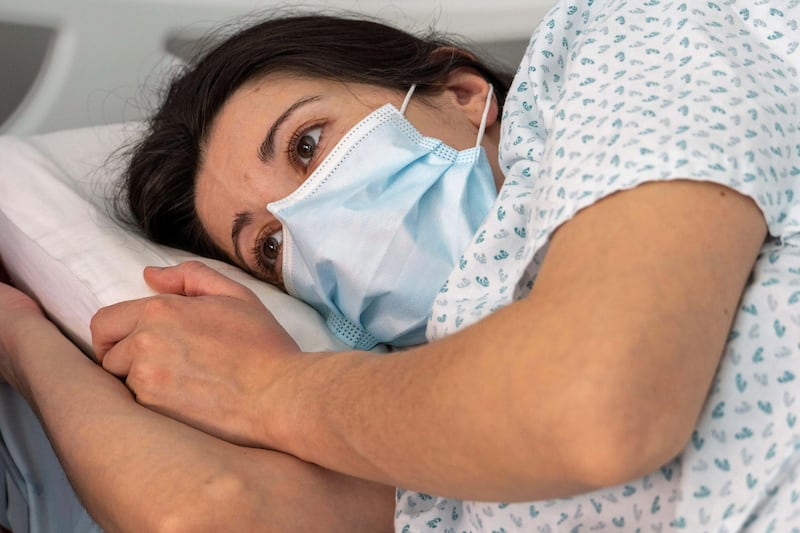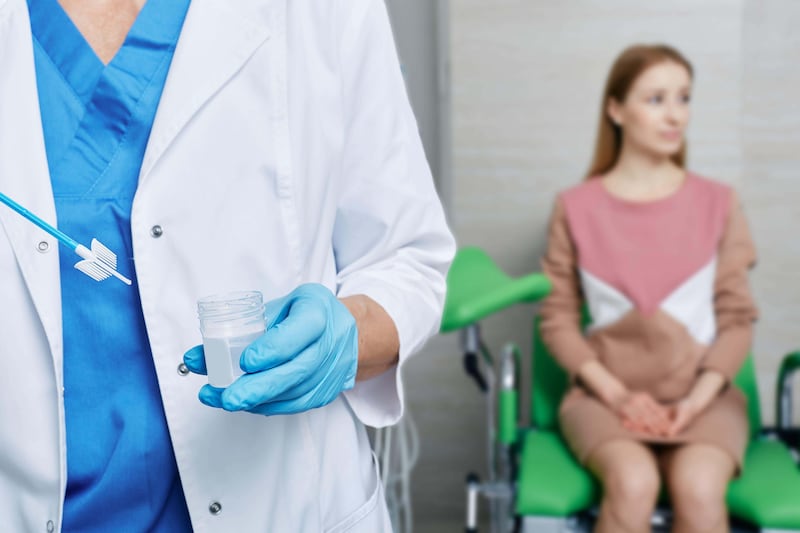THERE is a rush of warm air as Teresa Brevini opens the incubator, kept at a blood-warm 37C, in the corner of the laboratory. She lifts out a tray of Petri dishes and tilts them to give me a better view. Just visible are pinhead-sized specks, suspended in a drop of clear fluid.
It would take a microscope with magnification 200 times greater than the naked eye to see that these aren't just specks of dust: they are miniature human organs, or organoids.
These function in the same way as full-scale organs, but measure no more than a few millimetres.
The ones Teresa is handling in this Cambridge laboratory are mini bile ducts, thin tubes that carry bile from the liver to the small intestine to help with digestion.
Teresa also has gut organoids in the incubator, while down the corridor a different team is developing brain organoids.
In fact, around the world, miniatures of everything from lungs to kidneys are being coaxed gently to life. And because they function just as organs do, they are perfect for research.
In May, scientists from the Austrian Academy of Sciences in Vienna announced that they had managed to develop an organoid heart the size of a sesame seed. It rhythmically beats and pumps just like a human heart, and the plan is to use it to help with the development of drugs.
A few weeks earlier, researchers from Boston University in the United States announced that they had developed gut organoids to test new treatments for Covid.
These tiny organs have also helped to reveal why so many Covid patients first developed gut-related symptoms, such as diarrhoea. When scientists infected gut organoids with the virus, it was found that it easily replicated in the gut lining.
Meanwhile, some of the organoids reared here, at the Wellcome-MRC Cambridge Stem Cell Institute, were used in December for the first time for a different purpose: to repair a human organ, a liver.
The breakthrough opens the door to the possibility of growing organoids as spare parts for organs damaged by disease or injury.
"Until now, we have tried to fix what has gone wrong, but now it looks like we can offer replacement parts - it is a big change," says Dr Fotios Sampaziotis, a hepatologist and clinical lecturer at the University of Cambridge, who led the experiment with a team from Addenbrooke's Hospital.

The development means there could be a safer, easier option for patients whose only hope of survival previously was a transplant.
"We can put the organoids in place with an injection, without the need for surgery," says Dr Sampaziotis.
"And we could give them earlier, before the patient is seriously ill."
A FUTURE USE AS DONOR ORGANS
The Cambridge breakthrough, published in the journal Science in February, also offers the chance to 'repair' organs once deemed unsuitable for organ donation.
"Despite the fact that there is a severe shortage of organs, some donated organs aren't used because they are not healthy enough for transplantation," says Dr Sampaziotis.
"With this new method you could take an organ you wouldn't normally transplant, refurbish it and then use it."
It is hoped that in the future the process can be scaled up, so an organoid can be used directly as a donor organ. Currently that's not feasible, as they lack a blood supply and tissue to connect them to the body.
In some cases, it may mean using a scaffold of collagen, for example, to help provide the correct organ shape for the organoids to grow around.
The organoid bile ducts that Teresa is handling are only a few days old, but they react just like a mature bile duct, swelling in the presence of hormones, pumping out water and repelling bile acid.
Under the microscope, you can see they have the same tube-shaped structure as a bile duct. Yet a few days ago, these were just a cluster of cells from the gallbladder.
They were placed in a nourishing 'soup', designed to recreate the environment a bile duct normally inhabits (and containing, for example, hormones and bile acids), to grow, and within days they became mini bile ducts.
As well as having to be kept blood-warm, the mini organs must be fed on the 'soup' to keep them from 'starving'. Teresa, a PhD student, has to top up this liquid every two days with a pipette.
"I even came in at Easter and on Christmas Day to make sure they didn't miss a feed," she says brightly.
THEY WORK JUST LIKE THE REAL THING
The ability for organoids to function in the body like 'real' organs is no distant dream.
One of the latest organoid developments is tear glands, which, when exposed to adrenaline in test tubes, were actually able to produce tears, reported the journal Cell Stem Cell in March.
This work was overseen by Hans Clevers, a professor at the Hubrecht Institute for Developmental Biology and Stem Cell Research in the Netherlands, in whose laboratory the very first organoid was developed just over a decade ago.
Organoids are being investigated in Japan as a way to repair the damage caused by inflammatory bowel disease, and, elsewhere, to repair defective salivary glands.
Meanwhile, in the Netherlands, gut organoids made with rectal cells from children with cystic fibrosis, a disease that affects the lungs and digestive system, are already routinely being used to see if patients will benefit from the drug ivacaftor.
The treatment can be hugely effective, but works in only 5 per cent of patients and is expensive (it costs around £300,000 a year).
So far, this kind of work has involved laboratory or animal studies, but then at midnight one night last December, Dr Sampaziotis received a call which led to the first use of organoids on a human organ. He was told that a liver unusable for transplant due to diseased bile ducts had become available, and so had a theatre in which to perform the experiment.
With the liver connected to a mechanical blood pump (to take on the work of the heart), he injected a quarter of a teaspoon of organoids, suspended in the growth medium, into the bile ducts.
Diseased bile ducts account for around one-third of the 1,000 or so adult liver transplants carried out in the UK each year, and 70 per cent of those required in children.
With younger patients, typically the cause is that they were born without bile ducts; in adults, they can become damaged by inflammation. Diseased or damaged bile ducts are also why a lot of donated livers are unusable.
Within 24 hours of the organoid injection, the function of the donor liver started to improve. Spellbound by the results, Dr Sampaziotis hardly left the theatre for the next 72 hours.
He could tell the organoids were working as the volume of bile going through the ducts was increasing.
When the team later examined the liver, they could see where the organoids - which had been dyed red - had physically repaired the damaged ducts.

The idea of being able to repair an organ without surgery, just with a simple injection, is extraordinary - but now well within reach.
"We would pass a camera on a small tube into the small bowel, find the bile duct and inject," says Dr Sampaziotis. "It would take 30 minutes."
Once injected, the organoids instinctively perform a sort of "self organisation" to find the closest bile duct cell "and line up to close any gaps", he explains.
"And once in place they aren't going to move around the body."
'ACCIDENT' THAT LED TO BREAKTHROUGH
They may be making their presence felt now, but organoids emerged only thanks to one of those serendipitous moments that transform medicine almost by mistake.
In 2008, Toshi Sato, a post-doctorate student in the laboratory of Professor Clevers, was tasked with adding a variety of growth factors to a Petri dish of stem cells from the gut to see if it sped up their growth.
"At the time, Toshi was quieter than usual as he had recently broken a piece of equipment in the laboratory," Professor Clevers recalls.
"I remember walking into the lab and saying, 'Toshi, are they growing?' And he casually said, 'Yes.'
"But when I looked down the microscope, there wasn't just a cluster of cells, we had a structure. The cells had organised themselves to become mini guts.
"We later dubbed them organoids. I remember thinking, 'Wow, this is the basis for research for the next 50 years.'"
Initial experiments used stem cells - master cells that can become other types of cells and normally help to perform running repairs on organs.
"We grew organoid pancreases and stomachs early on using these stem cells, but by making alterations to the growth medium, we began to realise we could grow every organ apart from the heart and brain," says Professor Clevers.
That is because there don't appear to be any stem cells in either of these organs.
Yet organoid technology can now use different types of cells to grow mini hearts and brains. This includes embryonic stem cells, taken from embryos fertilised in a Petri dish. This remains controversial.

It is also possible to make artificial versions of stem cells, although it's a slower process.
"You take any human cells - such as cells from a hair shaft. You play a trick with the DNA by adding different genes which you zap into the cells, and in so doing you reprogramme them," says Professor Clevers.
The Cambridge team didn't use stem cells at all, but cells from the gallbladder, which are flexible and can, with treatment, be made to behave like bile duct cells.
The growth medium is key, and this will differ according to the organoid being created. As well as vitamins, minerals and antibiotics (organoids lack a protective immune system), every organ has its own preferred menu of growth factors: breast tissue organoids prefer oestrogen, while lung organoids need air, so are grown on the surface of liquid.
The Cambridge team experimented using various growth factors.
"The cells grew - but in their original form as gallbladder cells," says Ludovic Vallier, a professor of regenerative medicine at the University of Cambridge, who co-led the work.
Then they added bile, "which we know influences very strongly the way cells work", says Professor Vallier. It worked: the gallbladder cells became bile duct cells.
While the Cambridge team has shown how organoids can help repair damage, in the world of cancer research another group is taking samples of tumours and growing cancer organoids to improve drug treatment.
"We know some cancers respond to chemotherapy but some don't, and sometimes we don't understand why," says Dr Hayley Francies, a principal staff scientist at the Wellcome Sanger Institute in London. "It's possible organoids can help."
One current drawback with organoids is time, she adds, explaining that to grow enough organoids to test a range of drugs could take months - which a patient might not have.
HOW CELLS CAN CUT ANIMAL TESTING
Another field where mini organs could transform current practice is drug development and testing.
"At the moment, drug testing is time-consuming and relies for a major part on animal models, and then you have to extrapolate what that could mean for a human," says Professor Vallier.
"That's one reason that 70 per cent of trials fail in the first stage of testing. Organoids offer an intermediate stage, so there would be less testing on animals - and safer testing on humans."
More immediately, organoids are to be used in human safety trials (using donor human livers), in the next few months.
Professor Vallier believes that if the trials go to plan, the treatment will be an option within five to 10 years. "We have already shown it's safe and possible in human organs," he says.
Meanwhile, the progenitors of organoids continue with their own groundbreaking research: Dr Toshi Sato is now in Tokyo working on a way to use organoids to help children with a rare bowel disorder.
And Professor Clevers is developing organoids of the conjunctiva - the cells the line the inside of the eyelids. Scarring as a result of a range of conditions, from infections to autoimmune disorders, is a common cause of blindness.
And then? "I look around to see what tissue hasn't been turned into an organoid yet, and then have a go," he says.
© Daily Mail







